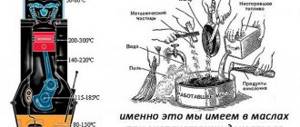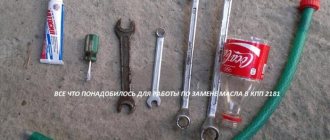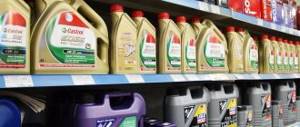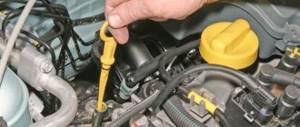The car's gearbox contains oil, which must be periodically checked, its condition assessed and, if necessary, replaced. During the next such check, small bubbles may be detected on the dipstick. This situation will indicate the presence of problems in the operation of the gearbox. If appropriate measures are not taken, the working unit will wear out intensively and will soon fail.
As a result of oil foaming, the effectiveness of lubrication of the internal parts of the mechanism decreases. The box heats up intensely, gears are more difficult to shift, the electronics cannot cope with the load and ultimately the entire mechanism fails. Next, you will need expensive and complex repairs or a complete replacement of the entire box.
It is necessary to respond to such a situation in a timely manner, immediately carry out diagnostics and eliminate the cause of the appearance of foam in the lubricant. We have to understand a complex and important problem that can affect every motorist.
Causes of automatic transmission oil foaming
Many factors can cause foam to form in transmission oil. Troubleshooting should always start with diagnosing and identifying the cause. This will make it easier to remove foam and prevent its further formation. Below we will examine all the reasons why automatic transmission oil foams.
Incorrect mixing
When it is necessary to replace technical fluids, in particular transmission oil, many car owners succumb to the temptation to save money. The fluids are not completely changed, but new oil is added to the required level. In this case, different liquids are mixed, which is unacceptable. Liquids produced by different manufacturers or with different markings should not be mixed with each other, otherwise foam may form.
Why does the oil foam in the gearbox? It's all about the chemical reactions that occur between the components of different lubricant compositions. This situation leads to the loss of the protective and operational properties of the lubricant.
There is only one way out of this situation - a complete replacement of the composition poured into the gearbox. All contents are drained, and the mechanism is washed using a special composition. It is important to use a special flush, as it can remove the remains of old grease that is unusable. The washing process must be repeated until there are no traces of oil left in the liquid. Before washing, you must remove the filter, if present. Before filling in new lubricant, the filter element is installed in its original place.
Abnormal oil level
The lubricating fluid must be held at a certain level, which is optimal for the normal operation of the device. An excess, as well as a deficiency, is a violation of the operation of the car, which will certainly lead to serious consequences if it is not eliminated in a timely manner.
There is an opinion among motorists that a slightly too high oil level in the gearbox has a beneficial effect on its operation. This statement is only true for some car models, and in most cases it is incorrect. Unfortunately, many drivers listen to this judgment and violate the standards set by the car manufacturer. For example, Mercedes-Benz, Toyota, Volkswagen, BMW cars are extremely sensitive to excessive oil levels in the transmission. Overfilling of lubricant can lead to torn gaskets, faulty valves and failure of clutches.
No less dangerous is a low oil level in the gearbox. Here, the type of transmission is completely unimportant: in manuals, automatic transmissions, and CVTs, breakdowns equally often occur due to oil that foams. Even very reliable mechanisms cannot withstand such use.
Air in transmission
The oil foams in automatic and manual transmissions due to the ingress of large quantities of air. It displaces the oil, replacing it. Air can enter due to depressurization of components, for example, when a hose ruptures or through cracks. It is strictly forbidden to operate a car in this condition, since with each kilometer traveled the amount of oil will quickly decrease.
To identify such a problem, it is necessary to carefully inspect the car, in particular the gearbox. Particular attention should be paid to the following elements:
- oil seals;
- a plate that connects the motor to the gearbox;
- rings;
- gaskets;
- lower part of the body.
It is convenient to identify leaks by traces of leaking liquid, which will have a characteristic color. It will not be enough to eliminate the leak and restore the system to its previous tightness. You will have to flush the gearbox and completely change the fluid. After all, dirt could get inside along with the air, which definitely shouldn’t be there.
Why does a gearbox need lubrication at all?
The automatic transmission operates on the basis of a torque converter, which transmits torque from the engine to the wheels. On the transmission side, the device is connected through shafts to an oil pump and a planetary mechanism. Gear control comes from a valve body connected to an electronic control unit.
The torque converter consists of two wheels with blades - a pump and a turbine, placed in ATF, between which a reactor is installed. The internal combustion engine acts on the hydraulic pump, causing the liquid to rotate the turbine under the influence of centrifugal force, while heating to high temperatures. With the help of a reactor, the torque is increased by 2 - 3 times.
The turbine wheel drives the gears of the planetary mechanism. They rotate freely in an oil environment until the gear is engaged. In this case, the corresponding gear is blocked by friction discs, which are compressed by pushers under fluid pressure. The pressure distribution in the required algorithm occurs according to the signal from the electromagnetic valves - solenoids located in the valve body.
Read
The design and principle of operation of the automatic transmission torque converter
Transmission fluid in an automatic transmission performs several functions:
- is a working fluid that transmits torque;
- creates pressure for smooth gear shifting;
- lubricates parts, preventing friction;
- cools the system, protecting against overheating.
Automatic transmission oil is selected taking into account its viscosity, type of chemical additives, and engine load tolerances. If the liquid foams, this means the box is not working properly and will soon wear out.
Exceeding the oil use life
Any lubricant cannot work forever. Over time, it loses its performance properties, so it needs to be replaced periodically. The instructions for the car indicate intervals for changing the lubricant in the transmission, which will be safe for the vehicle. They are always indicated with some margin, so deviations in a larger direction are possible.
There are general numbers that roughly apply to all cars. If you adhere to them, the service life of the transmission will increase significantly:
- the service life of mineral lubricant in an automatic machine is limited to 20–30 thousand km;
- synthetic lubricant in an automatic machine can properly serve for about 50 thousand km;
- mineral technical fluid should be poured into the mechanics every 30 thousand km;
- synthetics in mechanics require replacement every 70 thousand km;
- new synthetics are poured into the variator every 30 thousand km.
We have studied almost all the reasons that cause the oil in automatic transmissions, manual transmissions and variators to foam. There is very little left.
What should the driver do?
The first signals of a malfunction in the machine will be jolts and jerks when changing gears. Next, the automatic transmission will begin to skip or block gears, and then the hydraulic and electronic parts will fail.
In order not to miss the moment when the oil begins to foam, you need to regularly check its level and quality. Reliable measurements are obtained only after heating the working fluid to 80 - 90℃:
- Having previously driven 10 - 20 km, the car is stopped on a horizontal platform.
- The selector is set to “P” or “N” depending on the transmission model.
- At idle, take out the dipstick, wipe it dry, insert it back into the pipe for 5 seconds and take it out again.
- The correct ATF level is between the “Hot” notches.
- Red or light yellow oil indicates good condition.
- When checking the consistency, the oil should be immediately absorbed into the napkin.
Depending on the manufacturer, the checking algorithm may change; for example, in Honda, the dipstick is checked after turning off the engine.
Troubleshooting
If the ATF level is below about:
Read
Complete and partial oil change in automatic transmission Ford Explorer 5
- It is necessary to inspect the underbody of the car in search of leaks from the automatic transmission and carry out repairs if broken hoses, deformed parts, or worn gaskets are found;
- Add the same ATF that is filled into the box to the required level.
When the oil foams, its volume increases, so the level on the dipstick will be above the top notch. To make sure, when checking again, turn off the heated engine and wait until the liquid settles. Excess oil is drawn out using a technical syringe and a thin tube.
If foam in the gearbox oil occurs due to aging, overheating, or an unsuccessful mix of various fluids:
- Remove and wash the pan.
- Completely drain the unusable liquid.
- Replace filters.
- Clean the radiator.
- Fill with fresh fluid recommended by the manufacturer.
In the most advanced cases, it will be necessary to overhaul, diagnose and replace automatic transmission parts. In order not to bring the transmission to repair, you need to take into account the design features of both gasoline and diesel automatic transmissions during operation:
- sudden movements at the start and during braking overload the torque converter;
- when slipping for a long time or towing heavy trailers, the automatic machine overheats due to high loads;
- Automatic transmission needs regular maintenance.
Excessive overheating
The appearance of foam in the lubricant may occur as a result of its high heating. This situation can occur during aggressive driving. The automatic transmission sends a signal to the instrument panel when the oil heating temperature is exceeded. With mechanics, everything is more complicated, since the driver only has to guess about the temperature of the lubricant.
If the car participates in sports competitions, the gearbox must be equipped with a system for measuring oil temperature and alerting when a critical level is reached. In a car that is used in a big city, travels off-road and experiences high loads, the oil should be changed more often.
How to prevent foam from forming?
For preventive purposes, the motorist should periodically check the oil level in the gearbox and pay attention to the behavior of the car when moving when changing gears.
Thus, the presence of foam in the oil indicates a gearbox malfunction. There are many reasons for foaming fuel in the gearbox, ranging from the fact that air has entered the box, ending with the fact that there is a fluid leak through the sealing elements. It is possible to determine the exact nature of the malfunction if you carry out a full diagnosis of the vehicle.
The importance of timely repairs
Has the problem been identified? Have you determined the reason? It's time to start eliminating it. By the way, there is no way to delay this. Otherwise, when operating a car with foaming oil, after 10 thousand km, you can be left alone with a broken car. Such repairs will cost tens of times more than timely elimination of the cause.
If it is impossible to eliminate the cause of the malfunction, you will have to contact a service station for diagnostics. You need to choose a car service with a good reputation. Every minute counts, this is important for every motorist to understand.
General recommendations and prevention
At the end of our conversation, I would like to point out some recommendations and methods of prevention. If they are followed, foaming of the lubricant will be detected at the initial stage and eliminated in a timely manner.
- The lubricant level in the engine and gearbox should be checked every week, maximum once a month, but not less often.
- The technical fluid must be replaced within the time limits specified in the vehicle instructions.
- An aggressive driving style greatly wears out the car, including causing overheating of the oil and the appearance of foam.
- In Parking mode, you need to note all changes in the behavior of the car.
- At the slightest changes and the first signs of breakdown, it is necessary to diagnose and repair the car.
Any car requires care and attention. He will respond to this with impeccable work and a clear response to the driver’s commands. It is better to prevent any breakdown and eliminate it in the early stages. Otherwise, the car can stall in the middle of the road and become a real problem for its owner.











